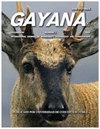A global review of the American mink (Neovison vison) removal techniques - Patagonia as a case study for their potential application
IF 0.4
4区 生物学
Q3 Agricultural and Biological Sciences
引用次数: 0
Abstract
American mink (Neovison vison) represents a threat to both biodiversity and economy in various regions of the world, including Patagonia. This invasive species has been successfully removed from many areas of Europe. In Chile and Argentina there have been only patchily distributed attempts of local control to date and large-scale removal has been considered unfeasible. We analyzed available scientific information, to determine best-fit strategies and improved methodologies that increase efficiency (capture per unit of effort) in American mink control. We reviewed published papers about programs that aimed at local control, functional or total eradication of minks in the Web of Science (WoS) database. Based on accessible information, the influence of some field variables on capture efficiency was determined through a General Lineal Model. From 1525 results in the WoS search, 51 papers refer to mink control action carried out in 28 areas of Europe and South America since 1992. Trapping has been the most used and efficient capture method. Short trapping periods that cover larger lineal distances per control program, and the use of attractants, specifically pheromones, have led to improved control efficiency. Chilean, Scottish and English experiences showed among the highest trapping efficiency values. We identify areas of research needed on mink ecology and behavior and trapping techniques that could improve trapping efficiency. A control program that incorporates the outcomes of this data assessment has the potential to improve feral mink removal. But further research is required to ensure that these efficiency measures result in cost-effective control in Patagonia.美国水貂(Neovison)去除技术的全球综述-以巴塔哥尼亚为例研究其潜在的应用
美国水貂(Neovison vison)对包括巴塔哥尼亚在内的世界各地的生物多样性和经济构成威胁。这种入侵物种已被成功地从欧洲许多地区清除。在智利和阿根廷,迄今为止只有零星分布的地方控制尝试,大规模清除被认为是不可行的。我们分析了现有的科学信息,以确定最适合的策略和改进的方法,以提高美国水貂控制的效率(单位努力捕获量)。我们回顾了在Web of Science (WoS)数据库中发表的关于局部控制、功能性或完全根除水貂的项目的论文。基于可获得的信息,通过一般线性模型确定了一些场变量对捕获效率的影响。从WoS搜索的1525个结果中,51篇论文提到了自1992年以来在欧洲和南美洲28个地区开展的貂控制行动。诱捕一直是最常用和最有效的捕获方法。每个控制程序的捕获时间较短,覆盖较长的直线距离,并使用引诱剂,特别是信息素,从而提高了控制效率。智利、苏格兰和英国的经验表明捕集效率值最高。我们确定了在水貂生态、行为和诱捕技术方面需要研究的领域,这些领域可以提高诱捕效率。结合这些数据评估结果的控制程序有可能改善野生水貂的清除。但需要进一步的研究,以确保这些效率措施在巴塔哥尼亚产生具有成本效益的控制。
本文章由计算机程序翻译,如有差异,请以英文原文为准。
求助全文
约1分钟内获得全文
求助全文
来源期刊

Gayana
ZOOLOGY-
CiteScore
1.30
自引率
0.00%
发文量
5
审稿时长
>12 weeks
期刊介绍:
GAYANA is a scientific journal published by Universidad de Concepción, Chile. It is the modern version of Gayana Oceanología and Gayana Zoología. Therefore its numeration starts at volume 63(1).
GAYANA covers all aspects of zoology and oceanographic research. It is structured in five sections, defined by subject or discipline: Ecology, Biodiversity and Taxonomy, Earth Sciences, Evolutionary, and Applied Biology and Environmental Biology. Each section is in charge of an editor who receives and manages the manuscripts sent for evaluation in close collaboration with the editorial board.
 求助内容:
求助内容: 应助结果提醒方式:
应助结果提醒方式:


